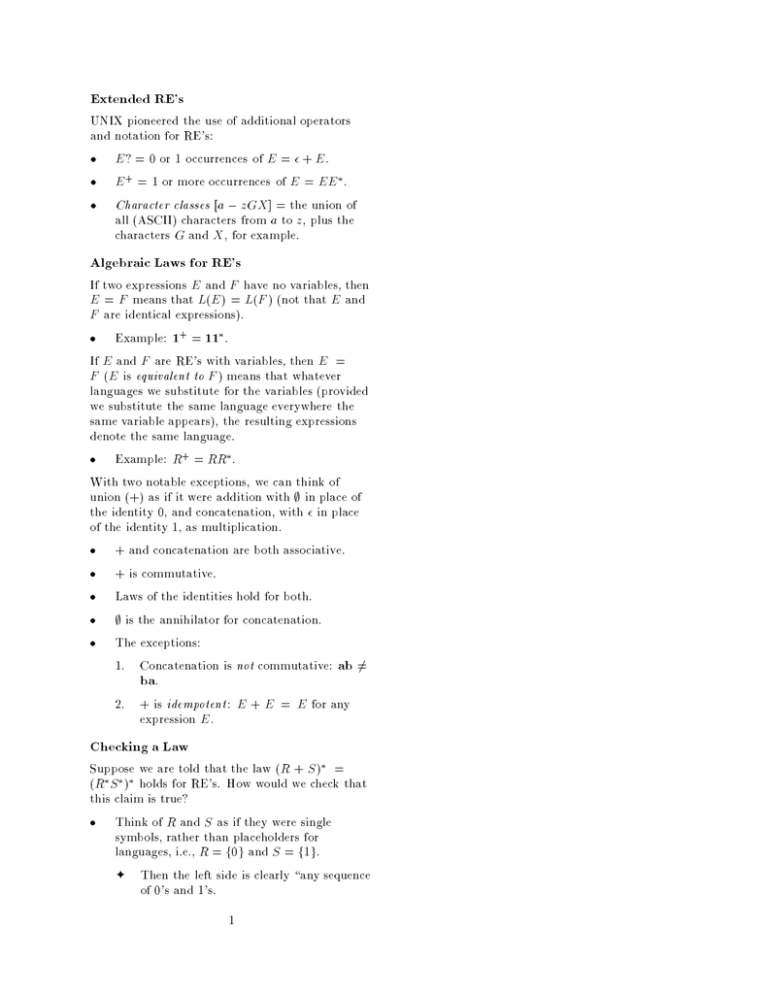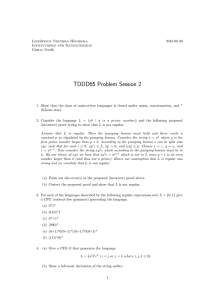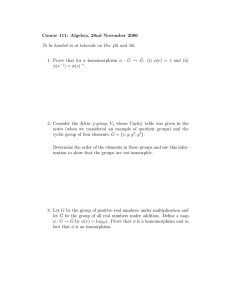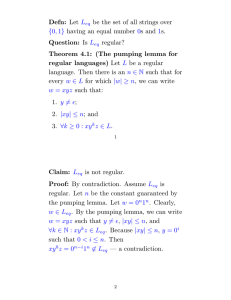Extended RE`s Algebraic Laws for RE`s ba
advertisement

Extended RE's UNIX pioneered the use of additional operators and notation for RE's: E? = 0 or 1 occurrences of E = + E. E + = 1 or more occurrences of E = EE . Character classes [a , zGX] = the union of all (ASCII) characters from a to z, plus the characters G and X, for example. Algebraic Laws for RE's If two expressions E and F have no variables, then E = F means that L(E) = L(F) (not that E and F are identical expressions). Example: 1+ = 11 . If E and F are RE's with variables, then E = F (E is equivalent to F) means that whatever languages we substitute for the variables (provided we substitute the same language everywhere the same variable appears), the resulting expressions denote the same language. Example: R+ = RR. With two notable exceptions, we can think of union (+) as if it were addition with ; in place of the identity 0, and concatenation, with in place of the identity 1, as multiplication. + and concatenation are both associative. + is commutative. Laws of the identities hold for both. ; is the annihilator for concatenation. The exceptions: 1. Concatenation is not commutative: ab 6= ba. 2. + is idempotent : E + E = E for any expression E. Checking a Law Suppose we are told that the law (R + S) = (R S ) holds for RE's. How would we check that this claim is true? Think of R and S as if they were single symbols, rather than placeholders for languages, i.e., R = f0g and S = f1g. ✦ Then the left side is clearly \any sequence of 0's and 1's. 1 The right side also denotes any string of 0's and 1's, since 0 and 1 are each in L(0 1 ). That test is necessary (i.e., if the test fails, then the law does not hold. ✦ We have particular languages that serve as a counterexample. But is it sucient (if the test succeeds, the law holds)? ✦ Proof of Suciency The book has a fairly simple argument for why, when the \concretized" expressions denote the same language, then the languages we get by substituting any languages for the variables are also the same. But if you think that's obvious, the book also has an example of \RE's with intersection" where the same statement is false. Also | is it clear that we can tell whether two RE's without variables denote the same language? ✦ Algorithm to do so will be covered. Closure Properties Not every language is a regular language. However, there are some rules that say \if these languages are regular, so is this one derived from them. There is also a powerful technique | the pumping lemma | that helps us prove a language not to be regular. Key tool: Since we know RE's, DFA's, NFA's, -NFA's all dene exactly the regular languages, we can use whichever representation suits us when proving something about a regular language. Pumping Lemma If L is a regular language, then there exists a constant n such that every string w in L, of length n or more, can we written as w = xyz, where: 1. 0 < jyj. 2. jxyj n. 2 3. For all i 0, wyi z is also in L. ✦ Note yi = y repeated i times; y0 = . The alternating quantiers in the logical statement of the PL makes it very complex: (8L)(9n)(8w)(9x; y; z)(8i). Proof of Pumping Lemma Since we claim L is regular, there must be a DFA A such that L = L(A). Let A have n states; choose this n for the pumping lemma. Let w be a string of length n in L, say w = a1 a2 am , where m n. Let qi be the state A is in after reading the rst i symbols of w. ✦ q0 = start state, q1 = (q0; a1), q2 = ^(q0; a1a2 ), etc. Since there are only n dierent states, two of q0; q1; : : :; qn must be the same; say qi = qj , where 0 i < j n. Let x = a1 ai ; y = ai+1 aj ; z = aj +1 am . Then by repeating the loop from qi to qi with label ai+1 aj zero times once, or more, we can show that xyi z is accepted by A. PL Use We use the PL to show a language L is not regular. Start by assuming L is regular. Then there must be some n that serves as the PL constant. ✦ We may no know what n is, but we can work the rest of the \game" with n as a parameter. We choose some w that is known to be in L. ✦ Typically, w depends on n. Applying the PL, we know w can be broken into xyz, satisfying the PL properties. ✦ Again, we may not know how to break w, so we use x; y; z as parameters. We derive a contradiction by picking i (which might depend on n, x, y, and/or z) such that xyi z is not in L. 3 Example Consider the set of strings of 0's whose length is a perfect square; formally L = f0i j i is a squareg. We claim L is not regular. Suppose L is regular. Then there is a constant n satisfying the PL conditions. Consider w = 0n2 , which is surely in L. Then w = xyz, where jxyj n and y 6= . By PL, xyyz is in L. But the length of xyyz is greater than n2 and no greater than n2 + n. However, the next perfect square after n2 is (n + 1)2 = n2 + 2n + 1. Thus, xyyz is not of square length and is not in L. Since we have derived a contradiction, the only unproved assumption | that L is regular | must be at fault, and we have a \proof by contradiction" that L is not regular. Closure Properties Certain operations on regular languages are guaranteed to produce regular languages. Example: the union of regular languages is regular; start with RE's, and apply + to get an RE for the union. Substitution Take a regular language L over some alphabet . For each a in , let La be a regular language. Let s be the substitution dened by s(a) = La for each a. ✦ Extend s to strings by s(a1 a2 an) = s(a1 )s(a2 ) s(an ); i.e., concatenate the languages La1 La2 Lan . ✦ Extend s to languages by s(M) =[w in M s(w). Then s(L) is regular. Proof That Substitution of Regular Languages Into a Regular Language is Regular Let R be a regular expression for language L. 4 Let Ra be a regular expression for language s(a) = La , for all symbols a in . Construct a RE E for s(L) by starting with R and replacing each symbol a by the RE La . Proof that L(E) = s(L) is an induction on the height of (the expression tree for) RE R. Basis : R is a single symbol, a. Then E = Ra, L = fag, and s(L) = s(fag) = L(Ra ). Cases where R is or ; easy. Induction : There are three cases, depending on whether R = R1 + R2, R = R1R2, or R = R1 . We'll do only R = R1R2. L = L1L2 , where L1 = L(R1) and L2 = L(R2 ). Let E1 be R1, with each a replaced by Ra, and E2 similarly. By the IH, L(E1 ) = s(L1 ) and L(E2 ) = s(L2 ). Thus, L(E) = s(L1 )s(L2 ) = s(L). Applications of the Substitution Theorem If L1 and L2 are regular, so is L1 L2 . Let s(a) = L1 and s(b) = L2 . Substitute into the regular language fabg. So is L1 [ L2 . ✦ Substitute into fa; bg. Ditto L1 . ✦ Substitute into L(a ). Closure under homomorphism = substitution of one string for each symbol. ✦ Special case of a substitution. ✦ Example: Homomorphism Let L = L(0 1 ), and let h be a homomorphism dened by h(0) = aa and h(1) = . , Then h(L) = L aa) = all strings of an even number of a's. Closure Under Inverse Homomorphism h,1 (L) = fw j h(w) is in Lg. 5 See argument in course reader. Briey: ✦ ✦ Given homomorphism h and regular language L, start with a DFA A for L. Construct DFA B for h,1 (L), by having B, go from state q to state p on input a if ^ q; h(a) = p. Closure Under Reversal The reverse of a string w = a1 a2 an is an a2a1 . Denoted wR . ✦ Note R = . The reverse of a language L is the set containing the reverse of each string in L. If L is regular, so is LR . ✦ Proof: use RE's, recursive reversal as in course reader. ✦ 6




